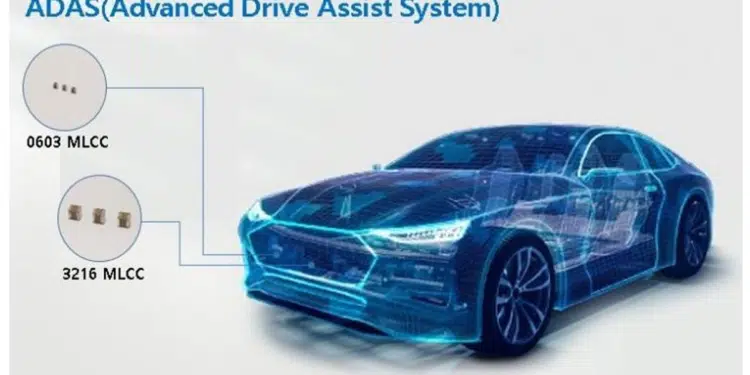Samsung Electro-Mechanics developed small-size, ultra-high-capacity MLCCs required for ADAS with improved durability such as rated voltage and bending strength. Advanced Drive Assist Systems (ADAS) has shown 20% annual growth in MLCC demand due to the increase in ADAS features for compact, large-capacity products due to the advancement of autonomous driving technology.
Samsung Electro-Mechanics announced that it has developed two types of automotive MLCCs that go in the Advanced Drive Assist System (ADAS), an essential safe driving system for autonomous vehicles.
Advanced Drive Assist Systems (ADAS) refer to technologies that control mechanical devices by recognizing and judging situations that may occur during autonomous driving, which include Lane Keeping Assist System (LKAS), Surround View Monitor (SVM), and Smart Cruise Control (SCC). With the advancement of vehicle functions, the number of high-performance semiconductors and components mounted inside the vehicle is gradually increasing. In particular, autonomous vehicles require reliable energy (power) supply and signal noise removal for various chips to receive signals quickly, and small-size and high-capacity MLCCs are required due to the lack of mounting space with the increasing number of components.
The MLCCs newly developed by Samsung Electro-Mechanics are a small-size product with the 0603 (0.6mm wide, 0.3mm long) size and a capacity of 100nF (nanofarad), and a high-capacity product with the 3216 (3.2mm wide, 1.6mm long) size and a capacity of 47μF (microfarad).
The 0603 MLCC achieved the same 100nF (nanofarad) capacity as the 1005 product while reducing the surface area by 64% compared to the 1005 (1.0mm wide, 0.5mm long) size. This product is mounted on the signal end of a vehicle’s electronic control unit (ECU) to eliminate surrounding signal noise and deliver signals accurately.
Furthermore, the bending strength of the new product is twice stronger than the standard to prevent the MLCC from being damaged by the shock and vibration sent during driving, increasing product reliability. In particular, the product meets AEC-Q200, the automotive electronic component reliability test standard, so it can be used not only in ADAS but also in other applications such as body, chassis, and infotainment.
The 3216-size (3.2mm wide and 1.6mm long) MLCC is a 47μF product that has more than double the capacity of a 22μF product, reliably supplying power to semiconductors in the vehicle. Recently, automotive semiconductors are becoming increasingly advanced to process more data quickly to keep up with advanced ADAS features. High-performance chips require high power consumption to operate. This is why high-capacity MLCCs that can store and supply a lot of energy are essential. Samsung Electro-Mechanics achieved the industry’s highest capacity among products of the same size by miniaturizing dielectric ceramic powder, a core material of MLCC, to a nano level as well as using an ultra-precise lamination method.
The durability was also improved by increasing the rated supply voltage (the maximum voltage that can be supplied without causing damage) by 1.5 times (4V → 6.3V) compared to the existing product while maintaining an ultra-high capacity of 47μF.
“The demand for compact, high-capacity and highly reliable MLCCs is increasing significantly with vehicles going electric,” said Dooyoung Kim, Executive Vice President of the Component Solution Unit at Samsung Electro-Mechanics. “Samsung Electro-Mechanics will strengthen its technological competitiveness by developing and manufacturing core raw materials for MLCCs, and expand the market share in automotive MLCCs by internalizing facilities and increasing production capacity.”
Samsung Electro-Mechanics is reinforcing its lineup of high-value-added electronic products with high-temperature, high-voltage, and high-reliability characteristics, based on its technological edge in the ultra-compact and ultra-high-capacity MLCC sector.
































